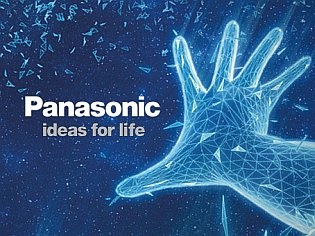-
Nachiket Mhatre
13th Sep 2013
Interview: Ashish Sasidharan, Product Head - Home Audio and Video, Panasonic India
Panasonic showcased its 2013 range of Viera LED televisions at its sprawling Experience Centre in the heart of New Delhi. Once you scratch past promo videos featuring cringe-inducingly happy families and disturbingly goofy friends hard selling the convergence of Internet and mobile devices with the 2013 Viera televisions, I found it uncanny how the TV range didn't really feature any new display technology.
To find out, I engaged Ashish Sasidharan, Product Head - Home Audio and Video, Panasonic India in a discussion about this sharp shift in R&D from improving basic display tech to the pursuit of a newer breed of smart TVs. Read on to find out why Panasonic has chosen to shift from plasma to LED technology, and how OLED and 4K televisions scenario will pan out in the consumer space.
Last year, Panasonic had announced that it won't produce any more plasma TVs or invest in R&D for the technology; however, this year we do have new plasma models. What's the official word on this?
Well, we will definitely be reducing our focus on plasma, because the market hasn't accepted it. What has been established in India over a period of time is that LED is the better technology than plasma. So we are reducing the focus on plasma.Will new Plasma TVs be released in the future?
We are still in the process of negotiating this. But it will definitely not be the highlight of our focus [in the TV business].To be completely unequivocal, will Panasonic be allocating any R&D budget for plasma technology?
There are certain discussions going on regarding this in Japan. However, as far as India is concerned, I can definitely say that plasma is not something that we will be focusing on. If it's still there, we will sell, otherwise not.So you're essentially saying that there may or may not be Panasonic plasma TVs in 2014.
Yes.
Why do you think plasma technology has lost out to LED TVs?
Well, it has lost out because it was only Panasonic that was promoting plasma technology, whereas LED technology was promoted by three industry giants. In [brightly lit] showroom conditions LED TVs appear brighter than plasma panels. People wrongly assume that brighter is better. However, if you take these TVs home you'll see that a plasma TV is much more soothing to the eyes and the picture quality is distinctly better than an LED display. In India the sale happens on the shop floor itself. People aren't bothered to do a study before buying. They just enter a shop and buy based on what's apparent there.How much of Panasonic's income goes into R&D?
We dedicate about three to four percent to research and development.What's your outlook on OLED and 4K-capable televisions? They currently cost around $9,000 to $15,000 for a 55-inch panel. How long do you think it will take for them to be viable?
My estimation is that maybe a year down the line, OLED TVs should become cheaper, but not exactly very affordable. It will take at least two years for this technology to be really affordable for the average consumer.By affordable, do you mean under a lakh rupees?
By that I mean the same price as current LED TVs [of the same size]. It will take nothing less than two years for that to happen. For 4K-capable TVs, there's another aspect to that. The content for that format doesn't exist at the moment. Till that happens, this technology would remain expensive. The price will come down as the economy of scale goes up. However, until then nothing's going to change.Is there any push from Panasonic towards 4K-capable playback hardware?
We have definitely discussed about getting this technology to India, but the cost again is driven by economies of scale.Currently, we don't have mainstream 4K format players as such in the market. Any idea how long will it take for them to become common?
I don't think it will come any sooner than two years, because Blu-ray by itself hasn't caught up in the market yet.When you compare Blu-ray with the CD or the DVD formats, the latter were adopted much quicker. Why do you think the Blu-ray format has been lagging?
There are many reasons behind such consumer behaviour towards Blu-ray. Firstly, the understanding of the consumer towards Blu-ray as a technology is very low. Secondly, if you see the content, it's not available for less than a thousand rupees. When you compare it to the DVD format, it is available at Rs 25 on account of piracy. Moreover, a [pirated] movie DVD will be available within two days [of the international release]. So a consumer would be more interested in spending Rs 2,000 on a DVD player and Rs 25 on the DVD. In comparison, a 2D Blu-ray player costs Rs 5,000, whereas a 3D Blu-ray player is available at Rs 10,000. However, the content or the software isn't available cheap, so people don't want to spend so much. Moreover, people don't understand the relevance of Blu-ray as a technology and what good it does [to picture quality] as most of their displays aren't Full HD.The promotional material for your 2013 range of Viera televisions focused on everything but the underlying LCD panel technology. Why has that taken a backseat? Are there any changes in this aspect over the outgoing Viera range?
Yes, definitely. We have made a lot of changes. The very first feature we demonstrated was the touchscreen. That feature didn't exist last year, as far as plasma is concerned. So we have incorporated it to make the TV much more interactive for the consumers. Unlike a smartphone, which is a personal device, this is something that the entire family can enjoy together. Last year's models had the Swipe and Share feature, but they didn't have the Save Back feature. We only interacted with the television, but couldn't download anything from the TV to the phone. Now we have completed the upload and download loop, so to speak.Let me clarify the question. Your pitch for the 2013 Viera TV range doesn't mention anything in terms of display technology. Is there any improvement over the 2012 models as far as that is concerned?
The LED technology is the same. The picture quality, however, has become slightly better because of incremental changes. I mean, you could say that we haven't actually invested in any new technology as such.So the new TV range doesn't have any new patented display technology then?
Well, our LED TVs remain the same but as far as new technology is concerned we will be investing in OLEDs. That's what the display industry is doing right now. It's talking about 4K displays. But I think the Indian market is too nascent for that, and it would be too expensive for the consumers to afford.Would I be right in saying that Panasonic's focus with its 2013 TV range is more about convergence than actual display technology?
See, panel technology has always been there and we are building towards that, but the growth is incremental at the moment. We are trying to make the TV more interactive. It shouldn't just be a television, but the idea is to make the consumer understand that this is a space to enjoy with the family as well. The TV is the right medium for that. Because smartphones are private, the TV can offer the same in a more family oriented manner.What sort of demographic do you aim at with the Smart TVs? Are they meant for Kids, adolescents, or adults?
The Touch Pen feature in our 2013 plasma caters to children. At the same time it's also meant for people who understand television as a concept and they know that plasma is a better technology than LED. Some people do understand this, so we are catering to them. However, when it comes to [the 2013] LEDs [with Smart TV features] I don't think the kids would be too influenced by what it is, because it has features meant more for the [more grown up] smartphone generation.Your 2013 Viera range essentially allows consumers to use their tablets and smartphones in sync with the TV and cross-pollinate content across devices. What's stopping them from using the screens on these mobile devices itself instead of the TV?
That isn't the point. The idea is that you'd want to share what you're viewing on your phone with your friends and family. You can either take turns to watch the same on the small screen, or you can all watch it together on the big screen. With the, Viera you simply Swipe content from your mobile device and onto the TV. I think people are exhausted of viewing content on their mobile phones, and at some point they would want to see a website or use an app on the large screen. The Viera makes this possible. The idea being that be it apps, websites, photos, videos, or anything of that sort, it can be brought down to your phone or sent to the TV.So the main idea here is sharing content.
Yes, the idea is to enjoy yourselves in a family space.Thanks you for your time and sharing your views with our readers.
Why Panasonic Chose to Shift From Plasma to LED Technology | TechTree.com
Why Panasonic Chose to Shift From Plasma to LED Technology
We discuss the future of plasma technology, feasibility of upcoming OLED, 4K displays, and Panasonic's focus on its 2013 LED TV range.
News Corner
- DRIFE Begins Operations in Namma Bengaluru
- Sevenaire launches ‘NEPTUNE’ – 24W Portable Speaker with RGB LED Lights
- Inbase launches ‘Urban Q1 Pro’ TWS Earbuds with Smart Touch control in India
- Airtel announces Rs 6000 cashback on purchase of smartphones from leading brands
- 78% of Indians are saving to spend during the festive season and 72% will splurge on gadgets & electronics
- 5 Tips For Buying A TV This Festive Season
- Facebook launches its largest creator education program in India
- 5 educational tech toys for young and aspiring engineers
- Mid-range smartphones emerge as customer favourites this festive season, reveals Amazon survey
- COLORFUL Launches Onebot M24A1 AIO PC for Professionals







TECHTREE